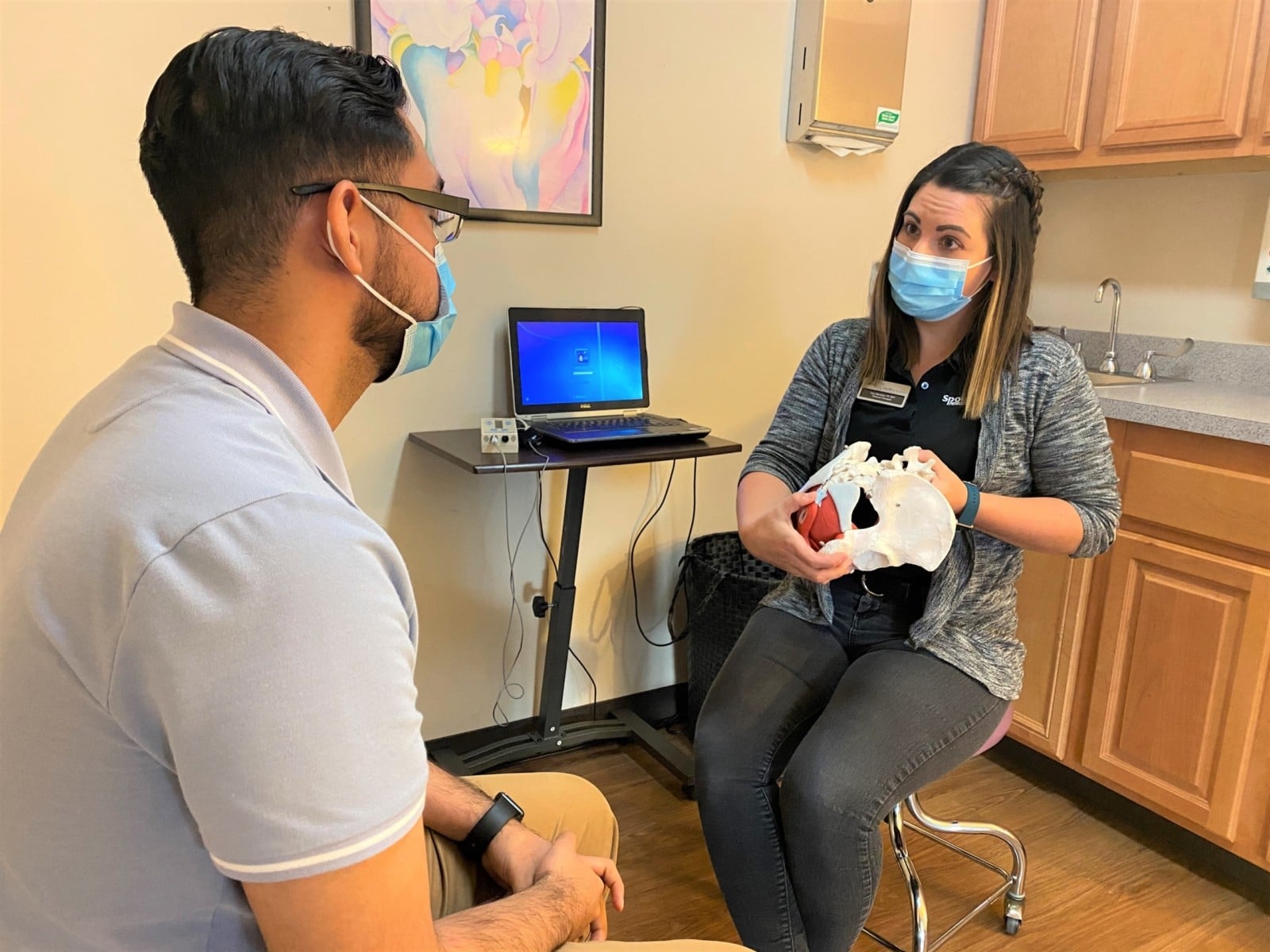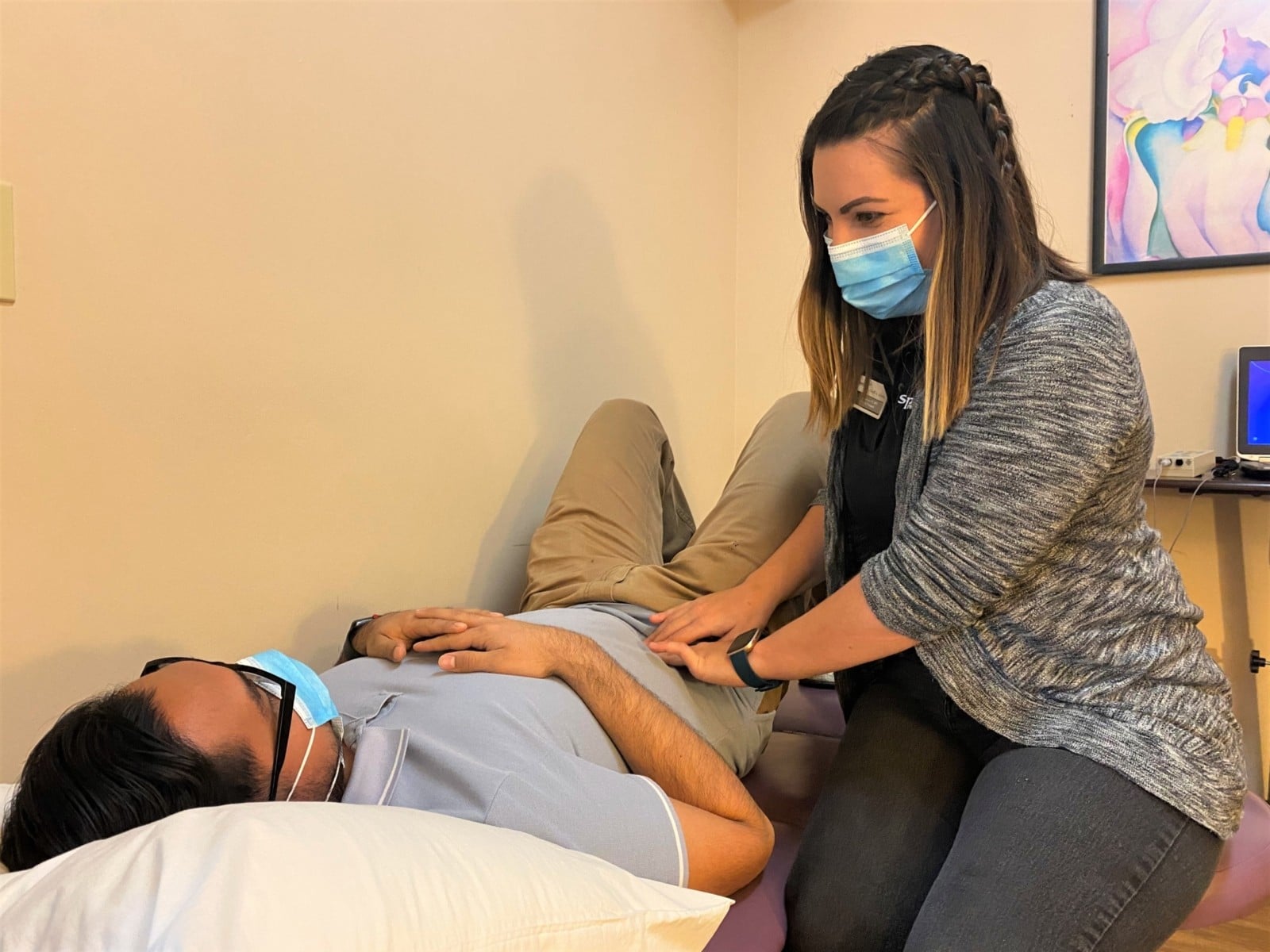1 in 7 men will be diagnosed with prostate cancer in their lifetime. Spooner physical therapist Cara Morrison, PT, DPT, a pelvic floor specialist says, “I think that in itself is really eye-opening. It’s really common. It’s also one of the most treatable cancers if it is caught early.”
“I didn’t know much about the pelvic health specialty practice for men until my last clinical rotation in PT school. I didn’t think there was that big of a population of men experiencing pelvic floor dysfunction until I started seeing it more frequently,” says Cara. Her grandfather passed away from prostate cancer when she was a child, so this particular patient population hits close to home for her and is part of the reason why she has pursued a focus on this specialty practice.
We talked more with Cara to learn more about pelvic floor dysfunction for men after a prostatectomy, how they can benefit from physical therapy, the specialty practice faces, and common misconceptions.
Turning to Physical Therapy After Your Prostatectomy
Research tells us that usually at the one-year mark after surgery, men who do or do not go to physical therapy are about at the same place in terms of urinary continence; however, the men who do decide to go to physical therapy can regain continence and confidence a lot more quickly than those who do not go to physical therapy.
Cara mentions this is because the men in physical therapy have a better knowledge, understanding, and coordination of their pelvic floor. Some people might argue this and ask if that would even matter. The shorter answer? It definitely matters. The longer answer? It makes a positive difference in lifestyle, from saving money on incontinence products to gaining confidence faster. With a boost in confidence, men are able to socialize how they wish and do the things they love more quickly than if they did not take action with physical therapy.
About 90% of men after a prostatectomy will have some level of urinary incontinence, from an occasional loss of a couple drops of urine with certain movements to constant leakage throughout the day. A major component of physical therapy for the pelvic floor is education. Education post-op is huge. Cara talks to her patients about what the surgery entails, where the prostate is in relation to the bladder, and why that typically leads to urinary incontinence. From there, she creates a treatment plan with the patient with a big emphasis on education on the pelvic floor and training them on how to utilize it to improve incontinence.
One of the main questions she’ll ask herself when working with her patients: Is the pelvic floor just really weak or is it just really tight and getting fatigued throughout the day? If it is tight and just getting fatigued throughout the day, that very well could be the cause of the urinary incontinence. This question allows her to determine if they need to go down the relaxation route or the strengthening route, or even possibly a combination of the two.
The Sooner, the Better
Well, how long should you wait to go to physical therapy after your surgery? The sooner, the better. Cara says that ideally, after surgery, she would like to start seeing patients about six weeks post-op because that is the time when patients check in with their doctors to check in on the tissue healing process. “Six weeks is typically the amount of time it takes for enough tissue healing to happen and when we can do a proper pelvic floor exam,” explains Cara. Once tissue healing has occurred, she can get a better sense of their urinary function, as it may ebb and flow up to that point.
Going to physical therapy before surgery can also set you up for success post-surgery! Cara says, “They are not necessarily going to gain a ton of strength if it is only one or two weeks before surgery. But just working on that neuromuscular coordination by knowing how to contract and relax their pelvic floor puts them in a really good spot post-surgery. If they come in beforehand, we have tools like external pelvic floor biofeedback, abdominal strengthening, and pelvic floor strengthening to at least get them started.”

Common Misconceptions
Navigating the world of pelvic floor health can be confusing and misleading at times. Cara explains, “There is still a lot of confusion in the specialty. Even when my male patients show up to appointments, one of the first things they ask me is why it is under ‘Women’s Health.’” She believes Women’s Health and Pelvic Health need to be so much more inclusive than what it currently is. Discussions are happening within the specialty, and little by little, things are moving in the right direction. She mentioned that even within the APTA, their Section on Women’s Health has recently been renamed the Academy of Pelvic Floor Physical Therapy. That is a positive step in the right direction for the specialty practice.
Another misconception: Kegels. That is by far the biggest misconception when it comes to pelvic floor physical therapy for both women and men. People think that only women do Kegel exercises, and they only do them after childbirth. That is not the case, and a lot of education is needed to debunk this myth. Additionally, Kegels aren’t for everyone! As mentioned earlier, a hyperactive or really tight pelvic floor can also be a cause of urinary incontinence, so it is best to be properly examined to determine the correct treatment program.
Cara says that both men and women may not be fully aware of the treatment and care they can receive if they are experiencing pelvic floor dysfunction. Some people might not choose to talk about it with their physicians, while others might simply just not know physical therapy is an option of care.
People might dismiss their issues and not take action, which can ultimately lead to greater issues down the road. Rather than turning to medication or surgery, please know that there is treatment and care available to put pelvic floor dysfunction to rest. “Accessible treatment and care are out there. We have the education, tools, and knowledge to help you,” explains Cara.
Getting Back on Course
Last year during her residency training, she began seeing a patient who had a prostatectomy back in 2009. He did not know about pelvic floor physical therapy until 2019! Ten years had gone by since his surgery, and he was still experiencing daily urinary incontinence. After having to experience going through 8 full Depends briefs a day and constantly leaking urine, including during his favorite activity of golfing, he was finally referred to physical therapy.
Cara says she was concerned with the amount of time that had passed since his surgery since most of what men can gain is within that 1-2 year post-op timeframe. Luckily, things started to turn around for him when they were able to cut down the number of briefs he was using in a day and a half through pelvic floor training, abdominal and hip strengthening, and education on proper diet and fluid intake. It was important for Cara to set realistic goals with him from the start, and they were able to make positive progress throughout his treatment. He was able to go back to golfing and enjoy the things he loves without having to worry as much about his urinary incontinence. That was a huge win for him!
“I was a patient of Cara’s in Nebraska before she left for your clinic in Arizona.
I had a prostatectomy and was immediately referred to her to start physical therapy using Kegel exercising for the severe urinary incontinence I was experiencing. Cara was very professional and made me feel comfortable in dealing with a slightly embarrassing problem. She educated me regarding the anatomy, physiology, and pathology of prostate surgery and subsequent incontinence.
She gave me new exercises each week and checked my progress during each visit. She was extremely positive about my treatment, and over about 8 weeks, I went from almost complete incontinence to full control. It was remarkable progress, in my opinion.
I highly recommend her for men recovering from prostatectomy. Your clinic made a very wise decision in her hiring.”
– Larry B., Omaha, NE
Do you have an upcoming prostatectomy? Learn more about Pelvic Health for Men at Spooner. Ready to schedule an appointment? Schedule an appointment or complimentary movement screen with a Spooner physical therapist at one of our locations throughout the Valley.

